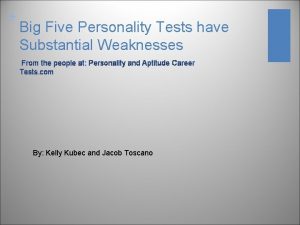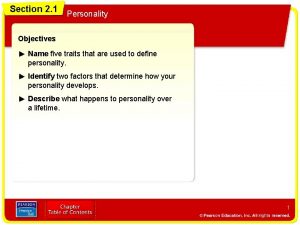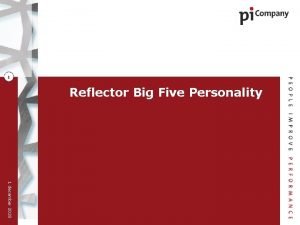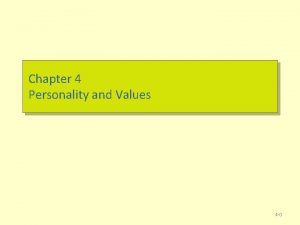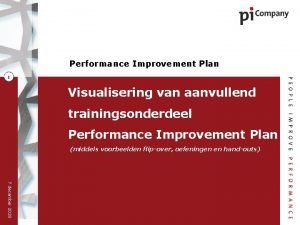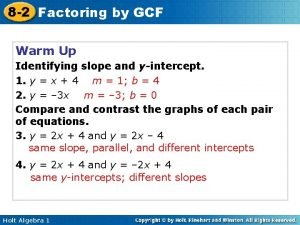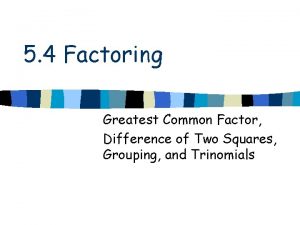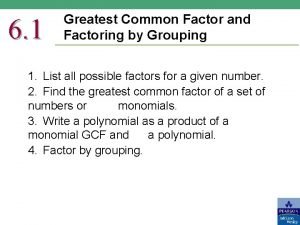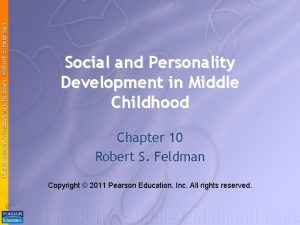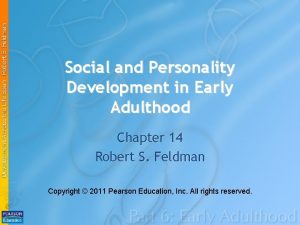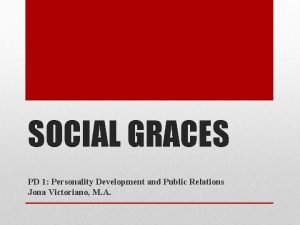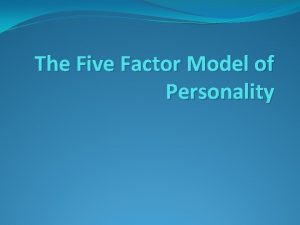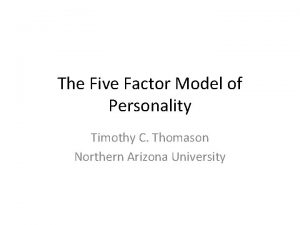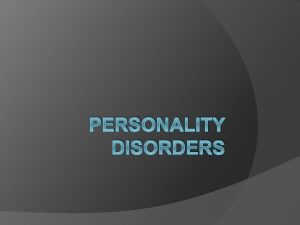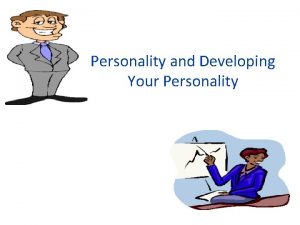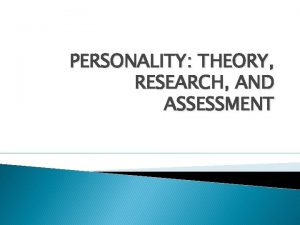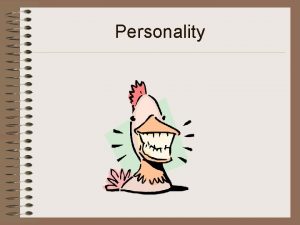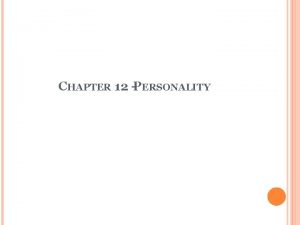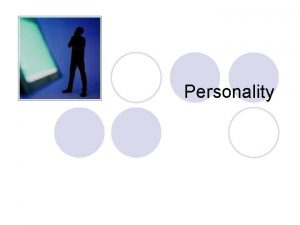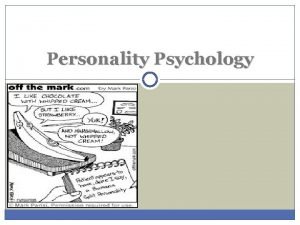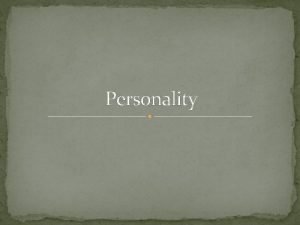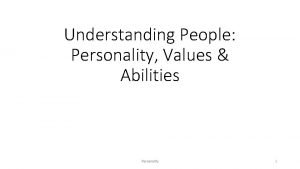The Five Factor Model of Personality and Social


























- Slides: 26

The Five Factor Model of Personality and Social Service Leadership Presentation at the 29 th Annual Conference of the Network for Social Work Management June 15, 2018 San Diego, California Linda Helm, MSW, Ph. D, LISW-S Richard Boettcher, MSW, Ph. D, LISW-S Lois Stepney, MSW, LISW

Lets Start off by Taking the Inventory!

Here a number of characteristics that may or may not apply to you. For example, do you agree that you are someone who likes to spend time with others? Please choose a number for each statement to indicate the extent to which you agree or disagree with that statement. Disagree strongly Disagree a little Neither agree nor disagree Agree a little Agree strongly 1 ---------------2 -----------------3 -------------------4 -----------------5 I see myself as someone who … ___ 1. is talkative ___ 2. tends to find fault with others ___ 3. does a thorough job ___ 4. is depressed, blue ___ 5. is original, comes up with new ideas ___ 6. is reserved ___ 7. is helpful and unselfish with others ___ 8. can be somewhat careless ___ 9. is relaxed, handles stress well ___ 10. is curious about many different things ___ 11. is full of energy ___ 12. starts quarrels with others ___ 13. is a reliable worker ___ 14. can be tense ___ 15. is ingenious, a deep thinker ___ 16. generates a lot of enthusiasm ___ 17. has a forgiving nature ___ 18. tends to be disorganized ___ 19. worries a lot ___ 20. has an active imagination ___ 21. tends to be quiet ___ 22. is generally trusting ___ 23. ___ 24. ___ 25. ___ 26. ___ 27. ___ 28. ___ 29. ___ 30. ___ 31. ___ 32. ___ 33. ___ 34. ___ 35. ___ 36. ___ 37. ___ 38. ___ 39. ___ 40. ___ 41. ___ 42. ___ 43. ___ 44. tends to be lazy is emotionally stable, not easily upset is inventive has an assertive personality can be cold and aloof perseveres until the task is finished can be moody values artistic, aesthetic experiences is sometimes shy, inhibited is considerate and kind to almost everyone does things efficiently remains calm in tense situations prefers work that is routine is outgoing, sociable is sometimes rude to others makes plans and follows through with them gets nervous easily likes to reflect, play with ideas has few artistic interests likes to cooperate with others is easily distracted is sophisticated in art, music, or literature

Big Five Inventory Scoring Key Reverse Scoring Key: 1=5, 2=4, 3=3, 4=2, 5=1 Extraversion Questions 1 6 R 11 16 21 R 7 12 R 17 22 13 18 R 23 R 14 19 26 31 R 26 Total Responses Add and Total Agreeableness Questions 2 R 27 R 32 37 R 42 Total 28 33 38 43 R Total Responses Add and Total Conscientiousness Questions 3 8 R Responses Add and Total Neuroticism Questions 4 9 R 24 R 29 34 R 39 Total Responses Add and Total Openness Questions Responses Add and Total 5 10 15 20 25 30 35 R 40 41 R 44 Total

Congratulations! You just generated your own Profile! But What does this mean? This is what the rest of the workshop will address!

Workshop Objectives • To explicate the Five Factor Model of Personality (FFM) • To critically review studies supporting the validity claims of the FFM • To examine several instruments currently used by researchers, clinicians and staff developers to measure FFM properties • To have workshop participants complete one FFM instrument and discuss results and the relationship to leadership development

What is the 5 Factor Model? • Historical background • The 5 Factors O C E A N Openness Conscientiousness Extraversion Agreeableness Non-neuroticism Easy to Remember Acronym OCEAN

What the Model is NOT! • A Model, Not a theory • No hypotheses regarding the origin of structure • Not a substitute for Myers-Briggs Types • No propositions about interior structure • Used to predict associations between effective leadership, teamwork, assertiveness, satisfaction in personal relations, etc.


The 6 Facets of the Factors (O) Openness (C) Conscientiousness (E) Extraversion (A) Agreeableness (N) Neuroticism O 1 Fantasy C 1 Competence E 1 Warmth A 1 Trust N 1 Anxiety O 2 Aesthetics C 2 Order E 2 Gregariousness A 2 Straightforwardness N 2 Angry Hostility O 3 Feelings C 3 Dutifulness E 3 Assertiveness A 3 Altruism N 3 Depression O 4 Actions C 4 Achievement Striving E 4 Activity A 4 Compliance N 4 Self. Consciousness O 5 Ideas C 5 Self-Discipline E 5 Excitement Seeking A 5 Modesty N 5 Impulsiveness O 6 Values C 6 Deliberation E 6 Positive Emotions A 6 Tender. Mindedness N 6 Vulnerability

Correlations of Factors • Extraversion is strongly related to overall work performance • True across multiple occupational groups including professionals , managers and supervisors • Conscientiousness shows the strongest association with specific task performance • Emotional stability is second to conscientiousness in relation to task performance • Agreeableness is positively related to interpersonal aspects of task performance • Collectively, the Big Five are strongly related to team performance • In our culture, persons who score high on extroversion, openness to new experience and agreeableness are more likely to become leaders then those who score low. • Leaders in commerce, business, manufacturing, medical administration, education, law, etc. score high in extraversion, openness to new experience, agreeableness and willingness to trust others.

Findings from the MMM Research Ten Item Personality Measure of the“BIG 5” Extraversion Introverts (6) In-Betweeners (16) Extraverts (36) n=58 Mean= 4. 53 TIPI Mean 4. 44 Mean= 5. 32 TIPI Mean 5. 23 Mean= 4. 19 TIPI Mean 5. 4 Mean= 5. 92 TIPI Mean 4. 83 Mean= 5. 8 TIPI Mean 5. 38 Agreeableness Conscientiousness Emotional Stability Openness *Score Averages from TIPI authors 12

Significant Studies The studies we are about to discuss are commonly cited as a basis for the Big 5 validity claims. q Meta-Analysis of the Relationship between the Five-Factor Model of Personality and Holland's Occupational Types. q Validating the NEO Personality Inventory using Assessor’s Ratings q Personality as a predictor of burnout among managers of manufacturing industries. q Do nice guys--and gals--really finish last? The joint effects of sex and agreeableness on income.

Study 1 Barrick, M. R. , Mount, M. K. , & Gupta, R. (2003). Meta-Analysis of the Relationship between the Five. Factor Model of Personality and Holland's Occupational Types. Personnel Psychology, 56(1), 45 -74.

Study 2 Furnham, A. , Crump, J. , & Whelan, J. (January 01, 1997). Validating the NEO Personality Inventory using Assessor's Ratings. Personality and Individual Differences, 22, 5, 669 -675.

Study 3 Methra, P. (2012). Personality as a predictor of burnout among managers of manufacturing industries. Journal of the Indian Academy of Applied Psychology, 32, pp 321 -328. .

Study 4 Judge, T. A. , Livingston, B. A. , & Hurst, C. (January 01, 2012). Do nice guys--and gals--really finish last? The joint effects of sex and agreeableness on income. Journal of Personality and Social Psychology, 102, 2, 390 -407.

Three Instruments Used to Measure • The Beginnings: the Neuroticism-Extraversion. Openness Personality Inventory (Costa and Mc. Crae in 1978 • Leads directly to the NEO P I-R • NEO PI-R characteristics Lets take a look at an example of a NEO PI-R Actual Profile!

NEO PI-R Data Table


Shorter Measures NEO FFI The TIPI The BFI

60 50 40 30 20 10 0

Discussion of BFI Results • Enhance Self-Awareness • What do I need to do to upgrade my profile? • How can I do this? • Sources for more information on the FFM ( See citations on final slide) • Workshop evaluation Questions?

FFM References Barrick, M. R. , Mount, M. K. , & Gupta, R. (2003). Meta-analysis of the relationship between the five-factor model of personality and Holland's occupational types. Personnel Psychology, 56(1), 45 -74. Boettcher, R. & Helm, L. (2018) " A Study of the First 99 Monday Morning Managers: Key Findings". Human Service Organizations, 42(4) (forthcoming). Cain, S. (2013). Quiet: The power of introverts in a world that can't stop talking. New York: Broadway Paperbacks. Furnham, A. , Crump, J. , & Whelan, J. (January 01, 1997). Validating the NEO Personality Inventory using assessor's ratings. Personality and Individual Differences, 22, 5, 669 -675 John, O. P. , Naumann, L. P. , & Soto, C. J. (2008). Paradigm shift to the integrative big five trait taxonomy. In John, O. P. , Robins, R. W. , & Pervin, L. A. (Eds. ), Handbook of personality : theory and research. (pp. 114 - 156). New York, NY: Guilford Press. Retrieved from https: //ebookcentral-proquest-com. proxy. lib. ohio-state. edu John, O. P. , & Srivastava, S. (1999). The Big-Five trait taxonomy: History, measurement, and theoretical perspectives. In L. A. Pervin & O. P. John (Eds. ), Handbook of Personality: Theory and Research (Vol. 2, pp. 102– 138). New York: Guilford Press.

FFM References Jolijn Hendriks, A. A. , Hofstee, W. K. B. , & De Raad, B. (2002). The five-factor personality inventory: Assessing the big five by means of brief and concrete statements. In De Raad & Perugini, M. (Eds), Big Five Assessment. (pp. 79 - _). Seattle, Wa. : Hogrefe & Huber Publishers. Judge, T. A. , Livingston, B. A. , & Hurst, C. (January 01, 2012). Do nice guys--and gals—really finish last? The joint effects of sex and agreeableness on income. Journal of Personality and Social Psychology, 102, 2, 390 -407 Methra, P. (2012). Personality as a predictor of burnout among managers of manufacturing industries. Journal of the Indian Academy of Applied Psychology, 32, pp 321 -328. Mc. Crae, R. R. , & Costa, P. J. (1989). Reinterpreting the Myers-Briggs Type Indicator from the perspective of the five-factor model of personality. Journal Of Personality, 57(1), 17 -40. Morgeson, F. P. , Campion, M. A. , Dipboye, R. L. , Hollenbeck, J. R. , Murphy, K. , & Schmitt, N. (September 01, 2007). Reconsidering the use of personality tests personnel selection contexts. Personnel Psychology, 60, 3, 683 -729. in

FFM References Neal, A. , Yeo, G. , Koy, A. , & Xiao, T. (2012). Predicting the form and direction of work role performance from the Big 5 model of personality traits. Journal Of Organizational Behavior, 33(2), 175 -192. doi: 10. 1002/job. 742 Rosenthal, R. (January 01, 1990). How are we doing in soft psychology? (Comment). The American Psychologist, 45, 6. Seibert, S. E. & Kraimer, M. L. (2001). The five-factor model of personality and career success. Journal of Vocational Behavior, Vol. 58, Issue 1, February 2001, pp. 1 -21. Shiota, M. N. , Keltner, D. , & John, O. P. (2006). Positive emotion dispositions differentially associated with Big Five personality and attachment style. The Journal of Positive Psychology, 1, 61 -71. Tkach, C. , & Lyubomirsky, S. (2006). How do people pursue happiness? : Relating personality, happiness-increasing strategies, and well-being. Journal of Happiness Studies, 7, 183225. Wuenschel, P. (2006). The Diminishing Role of Social Work Administrators in Social Service Agencies: Issues for Consideration. Administration in Social Work, 30, 4, 5 -18.
 Five factor model facets
Five factor model facets Five elements and five senses
Five elements and five senses Average of sine wave
Average of sine wave What is the greatest common factor of 12 and 42
What is the greatest common factor of 12 and 42 What is the big five personality test
What is the big five personality test Personality objectives
Personality objectives Reflector personality professional
Reflector personality professional Big five personality traits
Big five personality traits Loopbaandadvies
Loopbaandadvies Apa itu social thinking
Apa itu social thinking Social thinking social influence social relations
Social thinking social influence social relations And all its aching joys are now no more
And all its aching joys are now no more Five of five
Five of five Drum and colors macbeth
Drum and colors macbeth Factoring in algebra
Factoring in algebra Factoring greatest common factor
Factoring greatest common factor Example of factor-relating question
Example of factor-relating question What is factored form
What is factored form Damon's stages of friendship
Damon's stages of friendship Personality development in early adulthood
Personality development in early adulthood What is social graces
What is social graces Models of group work
Models of group work Hình ảnh bộ gõ cơ thể búng tay
Hình ảnh bộ gõ cơ thể búng tay Ng-html
Ng-html Bổ thể
Bổ thể Tỉ lệ cơ thể trẻ em
Tỉ lệ cơ thể trẻ em Chó sói
Chó sói




